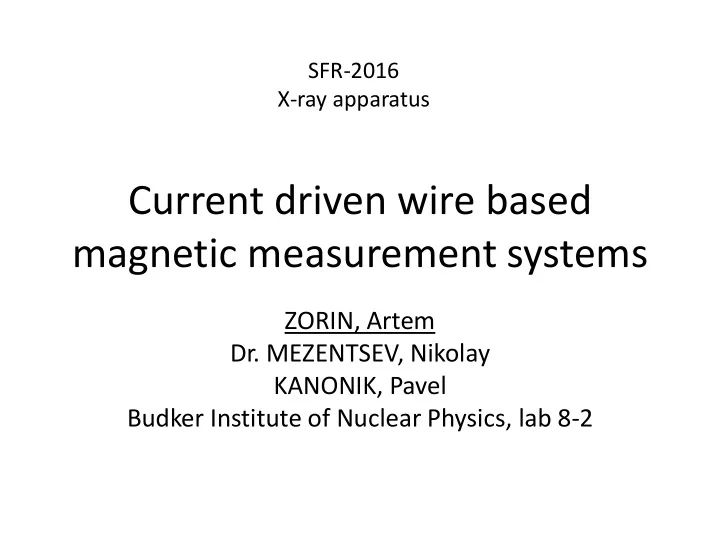

SFR-2016 X-ray apparatus Current driven wire based magnetic measurement systems ZORIN, Artem Dr. MEZENTSEV, Nikolay KANONIK, Pavel Budker Institute of Nuclear Physics, lab 8-2
Electron beam + magnetic field = synchrotron radiation. A wiggler/undulator = many magnets, but it is not a bending magnet. L J B ( s ) ds Electron beam trajectory 1 shouldn’t change. 0 L s J1 means angle, J2 means shift. J ds B ( s ) d s Tasks: minimize and measure J1, J2 2 0 0 and some other parameters. 2
3 PSU = B, J1, J2 3
Hall probe sensor • Liquid He • Much space • Much time, no ramping • Mechanics • Calibration 4
Moving wire based systems • Faraday's law of induction: moving wire + magnetic field = voltage • Different configurations of wire are possible: straight wire, coil, eight- form coil… • Mechanics • Much space 5
Current driven wire based systems • Current moves through stretched wire and interacts with magnetic field (Ampere force). The wire deflects, and its position is measured. Wiggler Sensor Sensor m 6
Constant current method δ X1 δ X2 Current wire I = 2A. L2 L1 p l1 l2 L T T x 1 x 2 -first field integral I first I * 1 2 I I L 1 L 2 L T T -- second field integral I I x ( x 2 x 1 ) sec ond 2 2 I I 7
Median plane Wiggler 150 focuses 100 50 y = 0,0143x + 9,8244 0 -2500 -2000 -1500 -1000 -500 0 500 1000 1500 2000 2500 -50 -100 -150 8
Sextupole measurement 40 30 20 10 0 -15 -10 -5 0 5 10 15 -10 -20 -30 -40 9 -50
Ramping up and down I1 I2 B meas B set 2.5 0.0001 2.0 0.0000 I1, T*m; I2, T*m*m 1.5 Field, T -0.0001 I1 I2 1.0 B meas B set -0.0002 2.5 0.00015 0.5 -0.0003 2.0 0.00010 0.0 I1, T*m; I2, T*m*m 0 50 100 150 200 250 300 350 400 1.5 0.00005 Field, T Time, s 1.0 0.00000 0.5 -0.00005 0.0 -0.00010 0 50 100 150 200 250 300 350 400 10 Time, s
Vibrating wire technique (resonant method) • Let 𝑔 0 is wire self-resonant frequency • Let 𝐵 is amplitude of oscillation (measured by a sensor) when the wire is driven by harmonic current frequency 𝑔 • It is possible to show that 𝐽 𝑔𝑗𝑠𝑡𝑢 ~ 𝐵(𝑔 = 𝑔 0 ) , 𝐽 𝑡𝑓𝑑𝑝𝑜𝑒 ~ 𝐵 𝑔 = 2𝑔 0 , and so on 11
• Sensor position • Phase detection • Coefficients, supports, calibration • Q-factor, time 12
Software interface 13
Pulsed Wire Method • J1 • J2 • Axis tilt • Axis offset 14
15
Problems • Sag, tension, sensitivity, I, diameter • Noise: wind, acoustic waves, vibration • Earth magnetic field • Wire imperfectness (for pulsed method) 16
Conclusion • Hall probe: liquid helium, constant field • Constant current method: the best for wigglers. Accuracy is better 5*10^-5 T*m, limited by PSUs • Vibrating wire (resonant) method: good for zeroing integrals, problems with calibration • Vibrating, pulsed methods: perspective for superconducting undulators 17
Thank you! 18
Recommend
More recommend